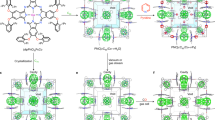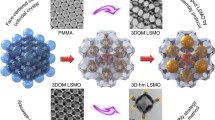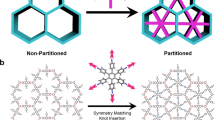Abstract
In this account, a new concept of “sponge crystals” is presented on the basis of new interpretation of our previous results of porous heteropolyacids, that is, porous aggregates of self-assembled (NH4)3PW12O40 nanocrystallites (Ito, Inumaru, and Misono, J. Phys. Chem. B 101 (1997) 9958; Chem. Mater. 13 (2001) 824) “Sponge crystals” are defined as single crystals having continuous voids within them, but unlike zeolites, no intrinsic structural pores. This new category includes molecular single crystals having continuous voids originating from series of neighboring vacancies (≥1 nm) of the constituent large molecules, affording nanospaces in the crystals. A typical example of “sponge crystals” is (NH4)3PW12O40, which is formed via the dropwise addition of ammonium hydrogen carbonate into an H3PW12O40 aqueous solution (titration method) at 368 K. The resulting (NH4)3PW12O40 nanocrystallites (ca. 6–8 nm) then self-assemble with the same crystal orientation to form porous dodecahedral aggregates in the solution. During the formation process, necks grow epitaxially between the surfaces of the nanocrystallites (“Epitaxial Self-Assembly”) to form aggregates of which each aggregate has an ordered structure as a whole single crystal. Although the crystal structure of (NH4)3PW12O40 has no intrinsic structural(“built-in”) pores, X-ray diffraction, electron diffraction and gas adsorption experiments all reveal that each (NH4)3PW12O40 aggregate is comprised of a single crystal bearing many micropores. These pores are considered to be continuous spaces as neighboring vacancies of the molecules (anions and cations) originating from the residual spaces between the self-assembled nanocrystallites. The porous (NH4)3PW12O40 single crystals are considered a special case of “mesocrystals,” as was recently discussed by Cölfen and Antonietti (Angew. Chem. Int. Ed. 44 (2005) 5576). In contrast to most “mesocrystals,” which are generally polycrystalline in nature, each aggregate of (NH4)3PW12O40 is a characteristic porous single crystal. Furthermore, the micropores of (NH4)3PW12O40 are totally different from those found in other microporous crystals: zeolites have “built-in” pores defined by their crystal structure, while the (NH4)3PW12O40 nanocrystallites have none. Since (NH4)3PW12O40 micropores are continuous spaces as neighboring vacancies of the molecules, the shapes of the (NH4)3PW12O40 pores can in principle, assume various connectivities or networks within the crystal, and as such, are subsequently termed: “sponge crystals.”











Similar content being viewed by others
References
C.B. Murray, C.R. Kagan, M.G. Bawendi, Ann. Rev. Mater. Sci. 30 (2000) 545
H. Cölfen, S. Mann, Angew. Chem. Int. Ed. 42 (2003) 2350
A. Stein, R.C. Schroden, Curr. Opin. Solid State Mater. Sci. 5 (2001) 553
O.D. Velev, T.A. Jade, R.F. Lobo, A. M. Lenhoff, Nature 389 (1997) 447
W. Luck, M. Klier, H. Wesslau, Ber. Bunsen-Ges. Phys. Chem. 67 (1963) 75
N.V. Dziomkina, G.J. Vancso, Soft Matter 1 (2005) 265
R. Schlögl, S.B. Abd Hamid, Angew. Chemie Int. Ed. 43 (2004) 1628
T.J. Barton, L.M. Bull, W.G. Klemperer, D.A. Loy, B. McEnaney, M. Misono, P.A. Monson, G. Pez, G.W. Scherer, J.C. Vartuli, O.M.K. Yaghi, Chem. Mater. 11 (1999) 2633
M. Misono, Catal. Rev.-Sci. Eng. 29 (1987) 269; 30 (1988) 339
T. Okuhara, M. Mizuno, M. Misono, Adv. Catal. 41 (1996) 113
N. Mizuno, M. Misono, Chem. Rev. 98 (1998) 199
M. Misono, Chem. Commun. (2001) 1141
S. Tatematsu, H. Hibi, T. Okuhara, and M. Misono, Chem. Lett. (1984) 865
T. Okuhara, A. Kasai, N. Hayakawa, Y. Yoneda, M. Misono, J. Catal. 83 (1983) 121
T. Okuhara, H. Watanabe, T. Nishimura, K. Inumaru, M. Misono, Chem. Mater. 12 (2000) 2230
T. Okuhara, T. Nishimura, and M. Misono, Chem. Lett. (1995) 155
T. Ito, K. Inumaru, M. Misono, J. Phys. Chem. B. 101 (1997) 9958
K. Inumaru, H. Nakajima, T. Ito, M. Misono, Chem. Lett. (1996) 559
M. Misono and K. Inumaru, JP1997–124311
T. Ito, I.-K. Song, K. Inumaru, and M. Misono, Chem. Lett. (1997) 727
T. Ito, K. Inumaru, M. Misono, Chem. Mater. 13 (2001) 824
T. Ito, K. Inumaru and M. Misono, Chem. Lett. (2000) 830
K. Inumaru, T. Ito, M. Misono, Micropor. Mesopor. Mater. 21 (1998) 629
H. Cölfen, M. Antonietti, Angew. Chem. Int. Ed. 44 (2005) 5576
T. Okuhara, Chem. Rev. 102 (2002) 3641
Y. Yoshinaga, K. Seki, T. Nakato, T. Okuhara, Angew. Chem. Int. Ed. Engl. 36 (1997) 2833
Y. Yoshinaga, T. Okuhara, J. Chem. Soc., Faraday Trans. 94 (1998) 2235
T. Okuhara, T. Yamada, K. Seki, K. Johkan, T. Nakato, Micropor. Mesopor. Mater. 21 (1998) 637
T. Yamada, Y. Yoshinaga, T. Okuhara, Bull. Chem. Soc. Jpn. 71 (1998) 2727
Y. Yoshinaga, K. Seki, T. Nakato, T. Okuhara, Angew. Chem. Int. Ed. Engl. 36 (1997) 2833
T. Okuhara, T. Yamada, K. Seki, K. Johkan, T. Nakato, Micropor. Mesopor. Mater. 21 (1998) 637
T. Okuhara, T. Nakato, Catal. Surv. Jpn. 2 (1999) 31
T. Yamada, K. Johkan, T. Okuhara, Micropor. Mesopor. Mater. 26 (1998) 109
M. Yosihmune, Y. Yoshinaga, T. Okuhara, Chem. Lett. (2002) 330
T. Yamada, Y. Yoshinaga, T. Okuhara, Bull. Chem. Soc. Jpn. 71 (1998) 2727
Y. Yoshinaga, T. Suzuki, M. Yoshimune, T. Okuhara, Top. Catal. 19 (2002) 179
T. Okuhara, Appl. Catal. A: Gen. 256 (2003) 213
S.T. Gregg, M.M. Tayyab, J. Chem. Soc., Faraday Trans., I 74 (1978) 348
J. B. McMonagle, J.B. Moffat, J. Colloid Interface Sci. 101 (1984) 479
D. Lapham, J.B. Moffat, Langmuir 7 (1991) 2273
S. Berndt, D. Herein, F. Zemlin, E. Beckmann, G. Weinberg, J. Schütze, G. Mestl, R. Schlögl, Ber. Bunsen-Ges. Phys. Chem. 102 (1998) 763
B. Judat, M. Kind J. Colloid Interface Sci. 269 (2004) 341
Acknowledgment
This account is based on the previous study, which was done at the University of Tokyo under the supervision of Prof. Makoto Misono and cooperation of Dr. Takeru Ito. This work was partially supported by a Grant-in-Aid from the Japan Ministry of Education for Science, Culture, Sports and Technology (MEXT), and a CREST project from the Japan Science and Technology Corporation (JST). The author thanks Dr. A. Toriki (Sumitomo 3M) for useful discussion.
Author information
Authors and Affiliations
Corresponding author
Rights and permissions
About this article
Cite this article
Inumaru, K. “Sponge Crystal”: a novel class of microporous single crystals formed by self-assembly of polyoxometalate (NH4)3PW12O40 nanocrystallites. Catal Surv Asia 10, 151–160 (2006). https://doi.org/10.1007/s10563-006-9014-9
Published:
Issue Date:
DOI: https://doi.org/10.1007/s10563-006-9014-9




